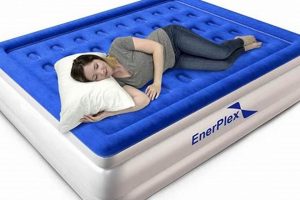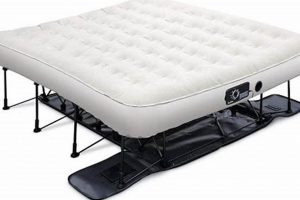This specialized support surface is designed to prevent and treat pressure injuries, commonly known as bedsores. These devices redistribute pressure and manage moisture, contributing to improved skin integrity for individuals at risk. The system typically incorporates a series of interconnected air bladders or cells that are inflated and deflated cyclically to reduce constant pressure on bony prominences. These support surfaces are often found in healthcare settings, providing a therapeutic environment for patients with limited mobility.
The significance of these systems lies in their ability to mitigate the risk of pressure ulcers, which can lead to pain, infection, and prolonged hospitalization. By offering a dynamic surface that conforms to the body’s contours and minimizes pressure points, these devices promote improved circulation and reduce tissue breakdown. Historically, advancements in materials and technology have led to more effective and user-friendly versions, enhancing patient comfort and care.
The following discussion will delve into the specific features, operation, and selection criteria associated with these pressure-reducing systems. It will further explore different types available and factors to consider when determining the most appropriate solution for individual patient needs, focusing on ensuring optimal therapeutic outcomes and preventative care.
Guidance on Using Support Surfaces Designed to Reduce Pressure
The following guidance provides essential information on the proper use and maintenance of specialized support surfaces to maximize their therapeutic benefits.
Tip 1: Proper Inflation is Crucial: Ensure the device is inflated to the manufacturer’s recommended pressure. Under-inflation or over-inflation can compromise the surface’s pressure redistribution capabilities, potentially increasing the risk of pressure injuries. Use the provided pressure gauge to verify correct settings.
Tip 2: Regular Inspection for Leaks: Routinely inspect the surface for any signs of leaks or damage. Punctures or tears can render the system ineffective and require immediate repair or replacement. Pay close attention to seams and valve connections.
Tip 3: Correct Mattress Overlay Placement: Verify that the overlay is properly positioned on the existing mattress. It should be securely fastened to prevent slippage, which could lead to uneven pressure distribution and discomfort.
Tip 4: Moisture Management is Key: Use moisture-wicking sheets and incontinence pads to minimize moisture accumulation on the skin. Excessive moisture can increase the risk of skin breakdown, negating the benefits of the support surface.
Tip 5: Weight Capacity Adherence: Always adhere to the manufacturer’s specified weight capacity. Exceeding the weight limit can damage the system and diminish its effectiveness in pressure redistribution.
Tip 6: Understanding Control Panel Settings: Familiarize oneself with the control panel settings and operation. Different settings may be available to adjust pressure, cycle times, and other parameters based on individual needs and clinical recommendations.
Tip 7: Routine Cleaning Protocol: Follow the manufacturer’s recommended cleaning protocol to maintain hygiene and prevent the spread of infection. Use appropriate disinfectants and avoid harsh chemicals that could damage the surface material.
Proper adherence to these guidelines will maximize the therapeutic benefits of the pressure-reducing system, contributing to improved patient outcomes and reduced risk of pressure injuries. Regular monitoring and diligent maintenance are essential for long-term effectiveness.
The subsequent section will address factors to consider when selecting an appropriate support surface for individual patient needs, including considerations of cost, features, and specific clinical requirements.
1. Pressure Redistribution
Pressure redistribution constitutes a core function in support surfaces designed to mitigate pressure injury risk. These surfaces address the challenge of prolonged, localized pressure on bony prominences, a significant factor in tissue ischemia and subsequent ulcer formation. The effectiveness of a support surface in redistributing pressure directly correlates with its ability to prevent and treat pressure injuries.
- Alternating Pressure Therapy
This facet involves the cyclical inflation and deflation of air cells within the support surface. This periodic change in pressure prevents prolonged compression of tissues, improving blood flow and reducing the risk of ischemia. A practical application includes settings where patients are unable to independently reposition themselves, such as intensive care units. Failure of the alternating pressure mechanism can lead to areas of sustained pressure, undermining the therapeutic benefits.
- Immersion and Envelopment
These characteristics refer to the support surface’s ability to conform to the body’s shape, maximizing contact area and minimizing peak pressures. Immersion describes how deeply the body sinks into the surface, while envelopment indicates how well the surface molds around the body’s contours. Inadequate immersion and envelopment can result in pressure concentrations on bony prominences, negating the redistributive effects of the support surface.
- Microclimate Management
The management of moisture and temperature at the skin surface directly impacts pressure redistribution. Excessive moisture macerates the skin, increasing its susceptibility to pressure damage. Low air loss technology can remove excess heat and humidity from the immediate vicinity of the patient’s skin. Inadequate microclimate management compromises the effectiveness of pressure redistribution efforts.
- Support Surface Material Properties
The material composition of the support surface influences its pressure redistribution capabilities. Materials with high elasticity and conformability better distribute pressure compared to rigid or non-conforming materials. Examples include specialized foams and fabrics designed for optimal pressure relief. The choice of material directly impacts the surface’s ability to minimize pressure concentrations and prevent tissue breakdown.
These facets underscore the complex interplay between surface design and physiological response in the context of pressure injury prevention. Effective pressure redistribution, achieved through these integrated features, forms a cornerstone of support surface therapy.
2. Moisture Management
Effective moisture management is a critical function of these therapeutic surfaces, as excessive moisture significantly elevates the risk of skin maceration and subsequent pressure injuries. The design and operation of
these systems directly address moisture accumulation on the skin surface, contributing to improved skin integrity and patient comfort.
- Low Air Loss Technology
This primary function involves the continuous circulation of air through the support surface, facilitating evaporation of moisture from the skin. The low air loss component draws away excess humidity, maintaining a drier microclimate. For example, in a patient with excessive perspiration, the system works to mitigate the buildup of moisture between the skin and the mattress surface, reducing the risk of maceration.
- Moisture-Wicking Materials
The fabric covering the support surface plays a crucial role in moisture management. Materials engineered with moisture-wicking properties actively draw moisture away from the skin and promote evaporation. An example is a woven fabric specifically designed to channel moisture away from the body, preventing it from pooling on the skin surface. The efficacy of these materials depends on their ability to quickly absorb and release moisture into the surrounding environment.
- Waterproof and Vapor-Permeable Barriers
The presence of a waterproof but vapor-permeable barrier beneath the surface material is essential for preventing fluid penetration into the mattress core. This barrier protects the internal components of the system from contamination while allowing moisture vapor to escape. In cases of incontinence, this barrier prevents urine from saturating the mattress, maintaining hygiene and preventing the growth of bacteria. The vapor-permeable characteristic allows for continued moisture evaporation, contributing to a drier surface.
- Adjustable Airflow Settings
Some advanced systems offer adjustable airflow settings, allowing clinicians to tailor the moisture management to individual patient needs. Increased airflow can be used in situations with high perspiration or incontinence, while reduced airflow may be appropriate for patients with sensitive skin. The ability to fine-tune airflow settings ensures optimal moisture control, adapting to varying patient conditions and environmental factors.
These interconnected facets of moisture management are vital for optimizing the therapeutic benefits of a low air loss surface. The effective control of moisture on the skin surface directly impacts the prevention of skin breakdown, highlighting the importance of these design considerations in promoting patient well-being and reducing the incidence of pressure injuries.
3. Airflow Regulation
Airflow regulation is an indispensable element of a low air loss mattress system, directly influencing its effectiveness in preventing pressure injuries and enhancing patient comfort. The principle behind these support surfaces lies in the controlled movement of air, which serves to manage moisture, regulate temperature, and reduce pressure on susceptible tissues. Without precise airflow regulation, the intended therapeutic benefits of a low air loss system are significantly compromised.
The primary mechanism by which airflow regulation contributes to pressure injury prevention is through the removal of excess moisture. A microclimate characterized by high humidity and elevated temperatures creates an environment conducive to skin maceration, weakening the skin’s barrier function and increasing its vulnerability to breakdown. The constant flow of air across the skin’s surface facilitates evaporation, thereby reducing the risk of maceration. Furthermore, airflow regulation aids in temperature control, preventing overheating and promoting a more comfortable sleeping surface. This is particularly important for individuals with impaired thermoregulation or those confined to bed for extended periods. An example of the practical significance of this understanding is the use of adjustable airflow settings to accommodate varying patient needs, such as increasing airflow for individuals with profuse sweating or reducing airflow for those with sensitive skin.
In summary, airflow regulation constitutes a critical component of the overall efficacy of a low air loss system. Its impact on moisture management, temperature control, and pressure redistribution directly influences patient outcomes. A failure to properly regulate airflow can undermine the therapeutic benefits of the system, potentially leading to increased risk of pressure injuries and reduced patient comfort. Therefore, understanding the intricacies of airflow regulation is paramount for healthcare professionals involved in the selection and management of these specialized support surfaces, ensuring their optimal utilization in the prevention and treatment of pressure-related complications.
4. Patient Comfort
Patient comfort is a central consideration in the design and application of support surfaces, particularly those utilizing low air loss technology. The therapeutic benefits of these surfaces are directly influenced by their ability to enhance the overall well-being and comfort of the individual using them.
- Pressure Redistribution and Discomfort Reduction
The primary function of pressure redistribution directly contributes to improved comfort. By minimizing pressure concentrations on bony prominences, these surfaces alleviate pain and discomfort associated with prolonged immobility. An individual confined to bed for extended periods may experience significant pain relief due to the enhanced pressure redistribution provided by the low air loss system.
- Temperature Regulation and Thermal Comfort
Low air loss systems facilitate airflow, which aids in regulating skin temperature and preventing overheating. Maintaining a comfortable skin temperature reduces sweating, skin irritation, and the overall sensation of being too hot or too cold. An example is the use of adjustable airflow settings to accommodate individual preferences for temperature, contributing to a more restful experience.
- Moisture Management and Skin Sensation
The ability of low air loss systems to manage moisture reduces skin maceration and promotes a drier microclimate. This results in a more comfortable sensation for the individual, as excessive moisture can lead to skin irritation and discomfort. The use of moisture-wicking fabrics further enhances this effect, contributing to a more pleasant tactile experience.
- Noise Reduction and Sleep Quality
The operation of low air loss systems can generate noise, which may disrupt sleep. Design considerations aimed at minimizing noise levels are crucial for enhancing patient comfort and promoting restful sleep. Advances in blower technology have led to quieter systems, improving the overall sleep environment for individuals utilizing these support surfaces.
These interconnected facets of patient comfort highlight the importance of considering the individual’s overall well-being when selecting and implementing low air loss systems. While therapeutic efficacy remains paramount, attention to comfort-related factors can significantly impact patient satisfaction, adherence to treatment protocols, and overall quality of life. The integration of comfort-enhancing features into low air loss technology demonstrates a commitment to holistic patient care.
5. Support Surface Integrity
Support surface integrity is a critical component of a low air loss mattress, directly impacting its functionality and therapeutic effectiveness. The design and materials used must withstand continuous use and maintain their structural integrity to ensure consistent pressure redistribution and airflow. Any compromise in the surfaces integrity, such as punctures, tears, or seam failures, can lead to loss of air, uneven pressure distribution, and a resultant increase in the risk of pressure injuries. For instance, a tear in the mattress cover could expose the internal air cells, leading to rapid deflation and loss of support in that area, concentrating pressure on underlying tissues. The structural soundness of the system is thus essential for its intended therapeutic purpose.
The materials used in the construction of these support surfaces are carefully selected to balance durability with patient comfort. The outer cover, often made of a waterproof and vapor-permeable fabric, must resist abrasion, tearing, and fluid penetration. Similarly, the internal air cells must be constructed from a material that can withstand repeated inflation and deflation cycles without degradation. Regular inspection and maintenance are necessary to identify and address any signs of wear or damage promptly. Consider, for example, a scenario in a long-term care facility where a mattress is routinely subjected to heavy use and cleaning; the integrity of the surface is tested daily, and proactive maintenance is vital to preventing failures that could compromise patient safety. The practical significance of maintaining this integrity is reflected in reduced patient morbidity, lower healthcare costs associated with treating pressure injuries, and improved quality of life for individuals requiring these support surfaces.
In conclusion, support surface integrity is not merely an aesthetic consideration; it is a fundamental requirement for the proper functioning of a low air loss mattress. The choice of materials, design features, and maintenance protocols must prioritize the sustained integrity of the system to ensure consistent therapeutic benefits. Challenges in maintaining this integrity include the constant demands of healthcare environments and the potential for accidental damage. Addressing these challenges through robust design, regular inspection, and appropriate maintenance practices is essential for maximizing the effectiveness and longevity of these vital support surfaces, thereby improving patient outcomes and reducing healthcare burdens.
6. Clinical Efficacy
Clinical efficacy, as it relates to these systems, denotes the measurable and demonstrable impact these support surfaces have on patient health outcomes. This encompasses the prevention and treatment of pressure injuries, as well as related clinical benefits. Evaluating the clinical efficacy of these specialized mattresses necessitates a rigorous assessment of their impact on patient morbidity, length of stay, and overall quality of life.
- Pressure Injury Incidence Reduction
A primary metric of clinical efficacy is the reduction in the incidence of hospital-acquired pressure injuries (HAPIs). Studies demonstrating a statistically significant decrease in HAPI rates among patients using these support surfaces provide strong evidence of clinical effectiveness. For example, a study comparing HAPI rates between patients on standard hospital mattresses and those on low air loss mattresses found a substantial reduction in HAPI incidence in the latter group. This reduction has direct implications for decreased patient suffering, reduced infection rates, and lower healthcare costs.
- Pressure Injury Healing Rates
For patients who have already developed pressure injuries, the rate of wound healing serves as an important indicator of clinical efficacy. These mattresses are designed to promote healing by reducing pressure, managing moisture, and improving circulation to the affected area. Clinical trials evaluating wound closure rates in patients with existing pressure injuries have shown accelerated healing times in those using low air loss support surfaces, compared to traditional wound care methods alone. This faster healing can lead to shorter hospital stays and improved patient comfort.
- Pain Management and Comfort Levels
Clinical efficacy also extends to the subjective experiences of patients, including pain management and comfort levels. These mattresses can alleviate pain associated with pressure injuries by redistributing pressure and reducing friction. Patient-reported outcomes, such as pain scores and comfort assessments, provide valuable insights into the overall effectiveness of these systems. Studies incorporating patient feedback have demonstrated improved pain control and increased comfort levels among patients using these surfaces, which can contribute to better sleep quality and overall well-being.
- Length of Stay and Resource Utilization
The clinical efficacy of these specialized surfaces can also be assessed by their impact on hospital length of stay and resource utilization. By preventing and treating pressure injuries, these systems can help reduce the need for prolonged hospitalizations, specialized wound care, and associated healthcare costs. Studies examining hospital discharge data have shown that patients using these mattresses may experience shorter hospital stays and require fewer wound care interventions, leading to cost savings for healthcare institutions.
In conclusion, the clinical efficacy of these specialized mattresses is multifaceted, encompassing pressure injury prevention, wound healing, pain management, and resource utilization. Rigorous clinical research, including randomized controlled trials, cohort studies, and patient-reported outcomes, provides the evidence base for these claims. The demonstrated clinical benefits of these systems support their use as an integral component of comprehensive pressure injury prevention and treatment strategies.
7. Cost-Effectiveness
The economic implications of utilizing these systems extend beyond the initial purchase price. A comprehensive cost-effectiveness analysis necessitates consideration of both direct and indirect costs, encompassing factors such as prevention of pressure injuries, reduction in treatment expenses, and associated resource utilization.
- Prevention of Pressure Injuries
The primary cost-saving factor stems from the prevention of pressure injuries. The treatment of established pressure injuries incurs substantial expenses, including wound care supplies, nursing time, and potential surgical interventions. These support surfaces, by mitigating the risk of pressure injury development, reduce the incidence of these costly complications. In healthcare facilities, proactive implementation of these mattresses can result in a significant reduction in expenditures associated with pressure injury management. Conversely, neglecting preventative measures can lead to escalating healthcare costs due to the increased burden of pressure injury treatment.
- Reduction in Treatment Expenses
Even in cases where pressure injuries do occur, utiliza
tion of these systems can contribute to reduced treatment expenses. By promoting a conducive healing environment, these mattresses can accelerate wound closure rates, decreasing the duration of treatment and the associated costs. For instance, a patient with a Stage II pressure injury may experience faster healing on a low air loss surface compared to a standard mattress, thereby minimizing the need for extensive wound care interventions and specialist consultations. This reduction in treatment complexity translates to lower overall costs for healthcare providers. - Resource Utilization and Staff Time
Efficient resource utilization represents another dimension of cost-effectiveness. These support surfaces can simplify nursing care, reducing the need for frequent repositioning and manual pressure relief. This allows nursing staff to allocate their time to other essential patient care activities. For example, in a busy intensive care unit, the implementation of these systems can free up nursing staff to focus on critical tasks such as medication administration and patient monitoring, improving overall patient care quality. This redistribution of staff time contributes to increased efficiency and reduced labor costs.
- Long-Term Cost Avoidance
The long-term cost avoidance associated with these systems extends beyond immediate treatment expenses. Prevention of chronic, non-healing pressure injuries reduces the risk of complications such as osteomyelitis and sepsis, which can lead to prolonged hospitalizations and significant morbidity. By preventing these severe complications, these support surfaces contribute to improved patient outcomes and reduced healthcare expenditures over time. Consider the case of an elderly patient at high risk for pressure injury development; proactive use of a low air loss surface can prevent a cascade of events leading to chronic illness and substantial healthcare costs.
These interconnected facets underscore the long-term cost benefits associated with the implementation of these pressure-redistributing support surfaces. While the initial investment may be higher compared to standard mattresses, the potential for preventing costly complications and optimizing resource utilization positions them as a cost-effective solution in the long run. A thorough cost-benefit analysis, taking into account both direct and indirect expenses, is essential for making informed decisions regarding the adoption of these specialized support systems.
Frequently Asked Questions
The following addresses common inquiries regarding specialized support surfaces designed for pressure injury prevention and management.
Question 1: What differentiates a low air loss mattress from a standard hospital mattress?
The primary distinction lies in the dynamic pressure redistribution and microclimate control capabilities. Standard mattresses offer a static surface, while these mattresses utilize air-filled bladders and airflow to minimize pressure concentrations and manage moisture accumulation.
Question 2: How does a low air loss mattress contribute to pressure injury prevention?
The system reduces pressure on bony prominences through cyclical inflation and deflation of air cells, promoting improved circulation and reducing tissue ischemia. Additionally, airflow facilitates moisture evaporation, mitigating the risk of skin maceration.
Question 3: Are low air loss mattresses suitable for all patients?
These systems are particularly beneficial for individuals at high risk for pressure injuries, including those with limited mobility, incontinence, or compromised nutritional status. Clinical assessment is necessary to determine the appropriateness of this support surface for individual patient needs.
Question 4: What maintenance is required for a low air loss mattress?
Routine maintenance includes regular inspection for leaks, cleaning according to manufacturer guidelines, and adherence to weight capacity limits. Proper maintenance ensures optimal performance and extends the lifespan of the system.
Question 5: Can a low air loss mattress cure an existing pressure injury?
While these mattresses promote a conducive environment for wound healing, they are not a standalone cure for established pressure injuries. They are an adjunctive therapy that should be used in conjunction with comprehensive wound care protocols.
Question 6: What are the potential drawbacks of using a low air loss mattress?
Potential drawbacks may include noise generated by the air pump, the need for a power source, and the initial cost. However, these factors must be weighed against the significant benefits in preventing and treating pressure injuries.
Proper understanding and utilization of these support systems can significantly improve patient outcomes and reduce the burden of pressure injuries.
The subsequent section will discuss future trends and innovations in support surface technology.
Conclusion
This exploration has elucidated the multifaceted aspects of low air loss mattress systems, from their operational principles to their clinical and economic implications. The significance of pressure redistribution, moisture management, and airflow regulation in preventing and treating pressure injuries has been thoroughly examined. Considerations of patient comfort, support surface integrity, and cost-effectiveness have also been addressed, providing a comprehensive understanding of these specialized support surfaces.
The continued refinement of low air loss mattress technology remains crucial for advancing patient care and reducing the incidence of pressure-related complications. Healthcare professionals and facilities are encouraged to critically evaluate the evidence-based benefits of these systems and integrate them appropriately into their prevention and treatment protocols to optimize patient outcomes and minimize healthcare costs.







